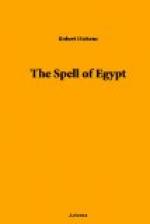Close to the right of the front of Medinet-Abu there are trees covered with yellow flowers; beyond are fields of doura. Behind the temple is a sterility which makes one think of metal. A great calm enfolds the place. The buildings are of the same color as the Colossi. When I speak of the buildings, I include the great temple, the pavilion of Rameses III., and the little temple, which together may be said to form Medinet-Abu. Whereas the temple of Luxor seems to open its arms to life, and the great fascination of the Ramesseum comes partly from its invasion by every traveling air and happy sun-ray, its openness and freedom, Medinet-Abu impresses by its colossal air of secrecy, by its fortress-like seclusion. Its walls are immensely thick, and are covered with figures the same color as the walls, some of them very tall. Thick-set, massive, heavy, almost warlike it is. Two seated statues within, statues with animals’ faces, steel-colored, or perhaps a little darker than that, look like savage warders ready to repel intrusion.
Passing between them, delicately as Agag, one enters an open space with ruins, upon the right of which is a low, small temple, grey in hue, and covered with inscriptions, which looks almost bowed under its tremendous weight of years. From this dignified, though tiny, veteran there comes a perpetual sound of birds. The birds in Egypt have no reverence for age. Never have I seen them more restless, more gay, or more impertinent, than in the immemorial ruins of the ancient land. Beyond is an enormous portal, on the lofty ceiling of which still linger traces of faded red and blue, which gives access to a great hall with rows of mighty columns, those on the left hand round, those on the right square, and almost terribly massive. There is in these no grace, as in the giant lotus columns of Karnak. Prodigious, heavy, barbaric, they are like a hymn in stone to Strength. There is something brutal in their aspect, which again makes one think of war, of assaults repelled, hordes beaten back like waves by a sea-wall. And still another great hall, with more gigantic columns, lies in the sun beyond, and a doorway through which seems to stare fiercely the edge of a hard and fiery mountain. Although one is roofed by the sky, there is something oppressive here; an imprisoned feeling comes over one. I could never be fond of Medinet-Abu, as I am fond of Luxor, of parts of Karnak, of the whole of delicious, poetical Philae. The big pylons, with their great walls sloping inward, sand-colored, and glowing with very pale yellow in the sun, the resistant walls, the brutal columns, the huge and almost savage scale of everything, always remind me of the violence in men, and also—I scarcely know why—make me think of the North, of sullen Northern castles by the sea, in places where skies are grey, and the white of foam and snow is married in angry nights.




